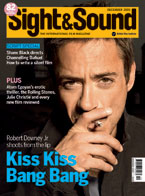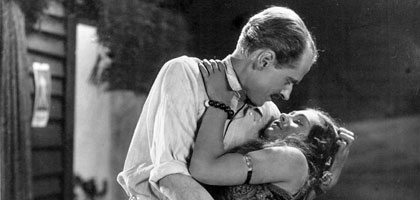
Script Special: The Man Who Wasn't There

Eliot Stannard wrote eight of Hitchcock's silent films and a screenwriting manual that, decades after the passing of the silent era, Michael Eaton finds more useful than any modern equivalent
Today's viewers, largely unaccustomed to the artistry of silent films, might well scratch their heads when faced with a question posed in 1920: "What is a Scenario Writer?" But it seems likely that readers of one of the earliest screenwriting manuals were equally nonplussed at the time of its publication, eight years or so before the adoption of sound. For the author ruefully admits: "Some of the Public believe this mystical and almost mythical person merely writes those fragments of explanation or dialogue technically known as sub-titles."
On those unavoidable occasions when the embarrassed screenwriter is forced to reveal his, in the present instance, trade, it is remarkable how frequently the public still assume that our job is merely to contribute the dialogue - those, that is, already sophisticated enough to know that the words are not made up by the actors. Little seems to have changed since the appearance of "Writing Screen Plays", Eliot Stannard's contribution to a book called Cinema Acting.
Who is Eliot Stannard? If the name is recognised these days it would most likely be for his writing credits on eight of Alfred Hitchcock's silent films, from his directorial debut (The Pleasure Garden, 1925) to his penultimate silent picture (The Manxman, 1927). Stannard, however, had already garnered over 80 screenwriting credits since he started in the trade in 1914, a decade before the grocer's son from Walthamstow waddled into Gainsborough Studios. Equally significantly, Stannard was one of the very first practitioners of the profession to think seriously and write publicly about exactly what it takes to be a writer for the screen. And his articles about the craft remain, to my mind, more analytical and useful than the shelves of 'how to' volumes that have proliferated in recent years.
These publications seem to be produced for the most part by disaffected scribes who have come to the realisation that it's far less challenging and ego-shattering to churn out a manual than to keep on having to pitch up in the bloody arena. Give me Eliot Stannard any day: a successful scenarist who, through trial and error and supreme confidence in his own abilities, helped to write the rule book. His work is still worth engaging with even if he was writing before the sound barrier was broken.
Stannard's first principles: the scenario writer must be "thoroughly experienced in each technical branch of Kinematography; possessed of dramatic training and a sense of Theatre; conversant with the laws of literary construction; a student of psychology and character; and alive to the atmospheric value of costume, furniture, architecture and scenery." How many of today's script editors (whose companies have stumped up for them to attend a weekend seminar by guru Robert McKee) could admit themselves adept at even one of these five essential requisites? How many writers could?
Above all, Stannard recognised the importance of what he called construction and we would call narrative structure. By far the majority of the scenarios he worked on were not original stories but adaptations of novels, plays, historical or biographical subjects, poems or even on one occasion a much reproduced painting, The Laughing Cavalier. This state remains much the same, for it is a reckless producer who is prepared to gamble on a 'property' that's not somehow 'pre-sold'.
Stannard's break came through adapting a tale written by his mother, a popular and prolific novelist who gloried in the nom de plume of John Strange Winter. In the course of his career he adapted the works of Fielding, Dickens, Emily Bronte and Shakespeare as well as of popular playwrights such as Galsworthy, Coward and Novello. But whatever the source material, high or low, he soon learned that the process of transformation should never be the preserve of "the lowest form of literary hack... a cut-and-slash trade". Cinema is a specific medium that must develop its own methods of communicating stories and emotions.
In the first of a series of articles on "The Art of Kinematography", published in The Kinematograph and Lantern Weekly in May 1918, he shared his secrets for the construction of screen dramas. His founding principles might be glossed mnemonically as CAST: Continuity, Atmosphere, Symbolism and Theme.
Unlike the writer of plays, who can develop the psychology of the characters through the spoken word, or the writer of prose fiction, who "can expiate to any length on the thoughts that are passing through the minds of his characters", the kinematographic narrative has to tell stories through continuous action. About his 1918 version of the popular play Hindle Wakes Stannard writes: "in Stanley Houghton's play... we are only told of Fanny's adventure in Blackpool with her employer's son, but in the film version we see every detail of that riotous adventure."
'Continuity', though, does not simply allow us access to sights beyond the confines of the proscenium arch. It can radically transform the relationship between the viewer and the tale through the choreography of knowledge. Lady Audley's Secret, Mary Elizabeth Braddon's sensational best-seller of 1862, was a stalwart of the stage and had twice been made into a film before the version Stannard churned out in 1920. The book, like many a mystery story, starts in media res, and only well into the tale are readers treated to melodramatic revelations of the mysterious lady's past nefarious actions. The film script, however, lays out the incidents of the plot chronologically... in continuity. Viewers see the low-born woman attempt murder to secure her elevated social position, so we spectators know far more about her than the other characters in the drama. The questions of the reader: 'Who is this woman and what is the secret of her past?' The questions of the spectator: 'What more must she do to cover up her crime and will she get away with it?'
Stannard never wrote himself about this film but it's clear that the "straight-line adaptation" - taking his viewers from the outset into the clandestine life of the central character - was a choice prompted by psychology, in accordance with his credo that we are not simply interested in what characters do but in understanding their "motive(s) for doing so". Today's viewers cannot but be struck that this method of continuity construction results in a pattern of suspense that would normally be deemed 'Hitchcockian' rather than 'Stannardian'.
'Atmosphere' should also be an expression of character and is therefore part of the writer's remit, too important to be left in the hands of the art department. The writer has to know the minutest details about the biography of the dramatis personae even if most of these peccadilloes never find their way on to the screen. Stannard recognised that it is the job of the writer to know what rooms the characters inhabit, what possessions they own, what clothes they wear. An obvious enough insight, perhaps, but how often, both on stage and screen, do we suspect that designers might be producing their visions to elicit admiring gasps from their fellow designers?
When it comes to 'Symbolism', the contribution of our forgotten man to the language of cinema is truly surprising. Without dialogue, instances of power and dominance, say, must be conveyed symbolically through staging, lighting, cutting. This might seem just a common-sensical matter of mise en scène, but it remains a sore point for the poor writer who all too often has to sacrifice control only to face critical calumny when the director shoots the text rather than the sub-text. When Stannard writes of his adaptation of John Galsworthy's Justice (about the devastating effects of an inhumane penal system on a young bank clerk, Falder, who committed a trivial crime from altruistic motives), it is evident that his notion of 'symbolism' encompasses a far more original aspiration for cinema semantics. It's worth quoting at some length because the film is lost.
"In his great play... Galsworthy relies upon the intonation of the actor's voice for much of his pathos and even his meaning. To translate these conditions and obtain the same effect through so different a medium as kinematography...I resorted to symbolism. To show the horrors of solitary confinement I showed in rapid succession: Falder locked in his cell; a dog chained to his kennel; a small bird imprisoned in a tiny cage; then in equally quick succession: happy children free from care romping in a sun-lit garden; a dog racing happily after a tennis ball; a lark soaring up to the heavens." In the play the Defence Counsel orates: "Justice is a machine that...rolls on of itself." In the picture this is made manifest by, as a triumphant review put it: "an Assyrian chariot wheel, with the protruding scythe that cuts down without pity everything in its path." What else is this but an instance of Eisenstein-ian 'intellectual montage' produced in England a decade before October? And who was it imagined this graphic impression of "the extraordinary contrast between captivity and liberty"? The original playwright? The director? No, it was the humble scenarist, ever the lowliest figure on the totem pole, bearing the weight of grander icons pressing down upon the shoulders.
When he insists on the organising centrality of 'Theme', Stannard bellows across the years. For him, the "universal error" of bad scripts is that they are "composed of a series of exciting incidents and nothing else... improbable and often impossible situations follow each other in bewildering rapidity... every scene which does not bear directly upon the central theme is a blemish to the scenario."
One thing Stannard was certain of was that the introduction of sound would be "a ghastly failure". Unsurprisingly in this light, his career did not survive the transition to talkies, despite his assurance: "It is a dangerous and hazardous pastime... to gaze into the future [but] one prophecy which is sure of fulfilment... is that nothing will ever persuade Eliot Stannard to disappear from the kinematograph industry." But disappear he did.
Patrick McGilligan, in his biography of Hitchcock, has Stannard working in some minor capacity for Gaumont in 1944, the year of his death, doubtless pathetically raging against the treacheries of the Fat Boy who stole from him all he knew and then decamped to Hollywood. But Charles Barr, as part of the dogged detective work undertaken for his 1999 book English Hitchcock, uncovered another story from fellow writer Sidney Gilliat's unpublished memoirs.
In this version Stannard finds himself working as a lowly clerk in a Motor Vehicle Licensing Department. Brooding over the cruel exigencies of fate in the boozer after work, he decides to return to the office - symbol of the enormity of his reduction - where he systematically rearranges the hated files "with a view to causing the maximum disturbance... for the longest possible time." Then the trickster walks out amidst the exploding doodlebugs, never to be seen again. I know which ending Stannard the writer would have preferred for Stannard - The Life.
There's no Blue Plaque, no biography. Most of the 116 films for which he has a credit are missing, believed dead. Marginal, ephemeral, unappreciated, obliterated, now is the hour for Eliot Stannard to be honoured as the patron saint of British screenwriters.
